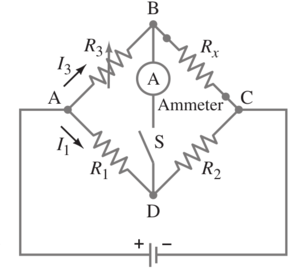Difference between revisions of "Chapter 26 Problem 71"
From 105/106 Lecture Notes by OBM
(→(a)) |
(→(a)) |
||
| Line 11: | Line 11: | ||
No current means the potential difference between B and D is zero. Thus | No current means the potential difference between B and D is zero. Thus | ||
| − | <math>V_{\textrm{BA}}= | + | <math>V_{\textrm{BA}}=V_{\textrm{DA}}</math> |
<math>\rightarrow I_3 R_3= I_1 R_1 </math> | <math>\rightarrow I_3 R_3= I_1 R_1 </math> | ||
<math>\rightarrow \frac{R_3}{R_1}= \frac{I_1}{I_3} </math> | <math>\rightarrow \frac{R_3}{R_1}= \frac{I_1}{I_3} </math> | ||
Revision as of 20:38, 24 April 2019
Problem
A Wheatstone bridge is a type of “bridge circuit” used to make measurements of resistance. The unknown resistance to be measured, , is placed in the circuit with accurately known resistances , , and . One of these, , is a variable resistor which is adjusted so that when the switch is closed momentarily, the ammeter A shows a zero current flow.
(a) Determine in terms of , , and .
(b) If a Wheatstone bridge is “balanced” when , , and , what is the value of the unknown resistance?
Solution
(a)
No current means the potential difference between B and D is zero. Thus
(b)














